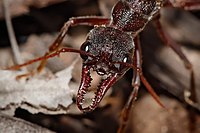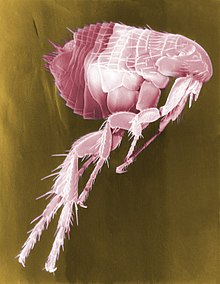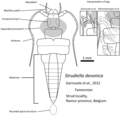The Insects Portal


Insects (from Latin insectum) are hexapod invertebrates of the class Insecta. They are the largest group within the arthropod phylum. Insects have a chitinous exoskeleton, a three-part body (head, thorax and abdomen), three pairs of jointed legs, compound eyes, and a pair of antennae. Insects are the most diverse group of animals, with more than a million described species; they represent more than half of all animal species. (Full article...)
Selected article -
Flea, the common name for the order Siphonaptera, includes 2,500 species of small flightless insects that live as external parasites of mammals and birds. Fleas live by ingesting the blood of their hosts. Adult fleas grow to about 3 millimetres (1⁄8 inch) long, are usually brown, and have bodies that are "flattened" sideways or narrow, enabling them to move through their hosts' fur or feathers. They lack wings; their hind legs are extremely well adapted for jumping. Their claws keep them from being dislodged, and their mouthparts are adapted for piercing skin and sucking blood. They can leap 50 times their body length, a feat second only to jumps made by another group of insects, the superfamily of froghoppers. Flea larvae are worm-like, with no limbs; they have chewing mouthparts and feed on organic debris left on their hosts' skin.
Genetic evidence indicates that fleas are a specialised lineage of parasitic scorpionflies (Mecoptera) sensu lato, most closely related to the family Nannochoristidae. The earliest known fleas lived in the Middle Jurassic; modern-looking forms appeared in the Cenozoic. Fleas probably originated on mammals first and expanded their reach to birds. Each species of flea specializes, more or less, on one species of host: many species of flea never breed on any other host; some are less selective. Some families of fleas are exclusive to a single host group; for example, the Malacopsyllidae are found only on armadillos, the Ischnopsyllidae only on bats, and the Chimaeropsyllidae only on elephant shrews. (Full article...)Did you know -
- ... that the Australian moth Abantiades latipennis is well-adapted to surviving clearfelling and thrives in regrowth forests?
- ... that out of the described snakefly specimens from the Florissant Formation, the Raphidia funerata holotype is the most complete?
- ... that Ctenomorphodes chronus is an Australian stick insect that resembles an eucalyptus twig, and the female lays 3-mm elliptical eggs that resemble plant seeds?
- ... that when a Japanese honeybee hive is invaded by a giant hornet scout, the honeybees "bake" the hornet in a ball of about 500 bees?
- ... that Acanthoplus discoidalis is able to squirt haemolymph up to 30 centimetres (11.8 in) when attacked by predators?
List articles
Related portals
General images -
Selected image -

Reduviidae (Hemiptera) is a large, cosmopolitan family of predatory insects, including the assassin bugs (genera include Melanolestes, Platymeris, Pselliopus, Rasahus, Reduvius, Rhiginia, Sinea, Triatoma, and Zelus), wheel bugs (Arilus cristatus) and thread-legged bugs (the subfamily Emesinae, including the genus Emesaya). There are about 7,000 species altogether, making it one of the largest families in the Hemiptera.
WikiProjects

Main WikiProject:
Related projects:
- WikiProject Arthropods
- WikiProject Spiders
- WikiProject Animals
- WikiProject Tree of Life
- WikiProject Biology
Daughter projects:
Tasks
 |
Here are some tasks awaiting attention:
|
Associated Wikimedia
The following Wikimedia Foundation sister projects provide more on this subject:
-
Commons
Free media repository -
Wikibooks
Free textbooks and manuals -
Wikidata
Free knowledge base -
Wikinews
Free-content news -
Wikiquote
Collection of quotations -
Wikisource
Free-content library -
Wikiversity
Free learning tools -
Wiktionary
Dictionary and thesaurus



















































